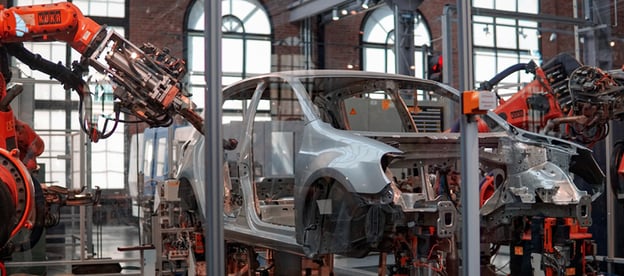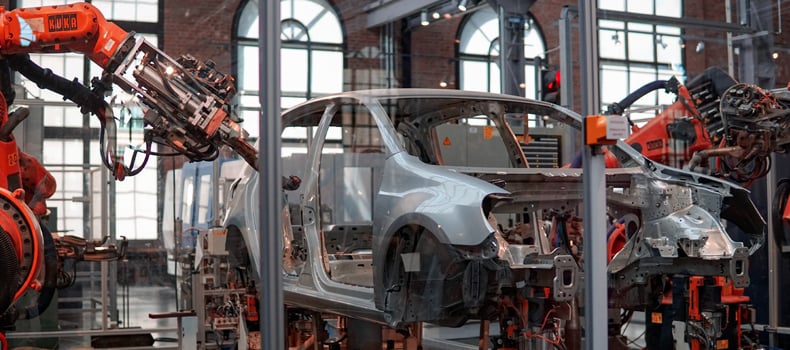Stay up to date with our latest news and insights
Supporting description on the types of content that feature in the blog.

By Marc Ueckermann, CTO, Xenith - Intelligent Workplace Services.
Manufacturing is a fascinating industry. Companies often have a constantly running production line where each part of the process is completed with the help of robotics and automation. So much so, that often when people think of automation, they reference production lines from food and drink to the automotive industry.
This isn’t a particularly new phenomenon - ideas of automation date back to the Second World War and a robotic automation boom in the 70s, which transformed the way we make cars and other automobiles.

But how wide-spread is the adoption of intelligent automation software (including RPA and Ai) in manufacturing?
Our research tells us that despite the use of hardware robots and other clever technologies, there are still a lot of “digital gaps” in the process. In fact, we find that very high tech companies often rely on paper, pens and manual intervention to keep everything running - processes fraught with monotony, the potential for human error, lack of compliance, and the inefficient use of time.
In this blog, we take a look at one of them - a high tech automobile manufacturer who asked us to help with their very own digital gaps.
As great as the robotics and machines that run the production line are, they can still break down and parts often need replacing. This on its own isn’t such an issue. Things break and they get fixed.
But how do you fix it?
Firstly, you have to find the manual and schematics - problem number one - in this case, the relevant documentation was stored away in ring binders.
Once you’ve got the right manual, you then need to find the part that’s broken. Then, you need to order a new part.
This isn’t an issue for a newer machine. This is where we encounter problem number two - the machine, in this case, is 30 years old and the company that used to replace the parts no longer exists or no longer supplies the part.
Worse still, is problem number three - the part itself might no longer be produced and you have to find an alternative. Now you’re now looking for a new supplier and a new part and you need to update the schematics to reflect the new part number for future cases.
This was a serious problem for the company we were working with. The cost of the production line not running while the repair is dealt with can be more than £30,000 an hour! Suddenly, a small issue becomes a lot of lost revenue and it’s a very bad week for those running the production line.
In many senses, the solution is about taking a page out of the manufacturing book. The production lines use state of the art robotics and automation and the back-office processes should be going the same way. Relying on an old paper manual when there is so much at stake can be damaging for many reasons, but above all, it can bring the whole production line to a halt when there’s an issue.
It’s for this reason that the first part of the solution is to digitise the paper documents. This gives quick accessibility and availability to documents relating to the production line, without the need to find the appropriate manual.
Through the same digitisation process, you can then create a database of part numbers that are updated regularly based on what’s available for that specific machine. Further still, the digitisation of this key information allows you to review and analyse how often a part is needed, and if the machine regularly needs a replacement, you can plan for the stoppages and keep parts in storage for when it happens.
What this means is that engineers on the production line are now carrying tablets with information about everything on the production line instead of large lever arch files with the information in. Information is now more accessible, but this doesn’t mitigate the risk of the parts not being available so still a risk costly downtime.
This is where the solution gets smart: Using Ai in the extraction process improves the data extraction results, which then feed a Robotics process which validates the gaps in parts information. If a gap is found, the solution can then go out to the web to try to find a replacement part or highlight this to the parts team so they can take action. Without Intelligent Automation it would be an impossible human task to check each line item, part number and update the parts database.
RPA can also be used to order parts and update stock if the engineers request the part from their tablets. The next stage would be to use the RPA to potentially price match and return the results so the business can evaluate their suppliers.
This is just one example of how a digital gap in a high-tech industry can cause disruption. However, we have seen similar examples in so many industries including food manufacturing, banking and even transport.
High tech industries often have ‘digital gaps’ that can be closed and paper still exists in a lot of back-office manufacturing processes.
If more companies took the initiative to automate paper-based processes in the way they do the production line, there is less risk of expensive downtime, they don’t have to worry about storing large paper files and production line managers can ensure the information is readily available when needed.
Supporting description on the types of content that feature in the blog.

20-09-2024
Digital document management tools offer a range of compelling benefits for businesses, including a PDF editor, a file converter and a form generator. You can also integrate with digital signatures qui...

20-09-2024
When choosing a SaaS software to deal with your company’s PDF documents and enable forms to be digitally sent and signed, you’ll want a product that’s user-friendly and easy to use. With Tungsten’s Po...

11-07-2024
Belkin is a global technology company that provides high-quality electronics products, from wireless chargers to power banks. Their people-centric approach and best-in-class functionality have positio...